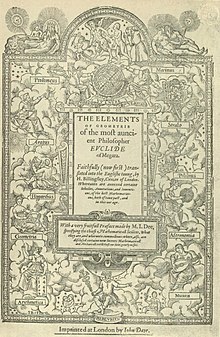Yr Elfennau
 | |
| Enghraifft o'r canlynol | gwaith ysgrifenedig |
|---|---|
| Awdur | Euclid |
| Iaith | Hen Roeg |
| Dechrau/Sefydlu | c. 3 g CC |
| Genre | traethawd |
| Prif bwnc | Geometreg Euclidaidd, mathemateg |
| Yn cynnwys | Elements Book 1, Elements Book 2, Elements Book 3, Elements Book 4, Elements Book 5, Elements Book 6, Elements Book 7, Elements Book 8, Elements Book 9, Elements Book 10, Elements Book 11, Elements Book 12, Elements Book 13 |
| Statws hawlfraint | parth cyhoeddus, parth cyhoeddus |
Traethawd ar fathemateg, a rannwyd i bymtheg 'llyfr', yw'r Elfennau gan y Groegwr Euclid; fe'i sgwennwyd, mae'n debyg, yn Alexandria, yr Aifft tua 300 CC. Mae'n gasgliad o ddiffiniadau, cynosodiadau, gosodiadau (theoremau a lluniadau), a sawl prawf o'r gosodiadau hyn. Mae'r llyfrau'n cwmpasu y ddau fath o'r hyn a adnabyddir heddiw fel geometreg Ewclidaidd: plân a solid[1], yn ogystal â damcaniaeth rhifau (elfennol) a llinellau anghymesur. Dyma'r gyfrol gyntaf y gwyddys amdano sy'n rhoi triniaeth ddiddwythol (deductive) i fathemateg, a hynny ar raddfa fawr. Ar sail y casgliad hwn y datblygodd rhesymeg a gwyddoniaeth fodern, ac ni chafwyd carreg filltir mor bwysig rhwng hynny a'r 19g.
Nododd sawl ysgolhaig mai dyma un o'r llyfrau mwyaf llwyddiannus a dylanwadol a welodd y byd erioed.[2][3][4]
Hwn oedd un o'r llyfrau cyntaf i gael ei argraffu yn 1482, a chredir ei fod yn ail i'r Beibl o ran sawl argraffiad a wnaed: ymhell dros fil.[4][5]

Cyfeiriadau
[golygu | golygu cod]- ↑ geiriadur.bangor.ac.uk; Y Termiadur Addysg - Cemeg a Bioleg, Ffiseg a Mathemateg; adalwyd 1 Ionawr 2018.
- ↑ Encyclopedia of Ancient Greece (2006) gan Nigel Guy Wilson, tudalen 278. Cyhoeddwyd gan Routledge Taylor a Francis Group. Dyfyniad yn yr iaith wreiddiol:"Euclid's Elements subsequently became the basis of all mathematical education, not only in the Roman and Byzantine periods, but right down to the mid-20th century, and it could be argued that it is the most successful textbook ever written."
- ↑ Boyer (1991). "Euclid of Alexandria". t. 100.
As teachers at the school he called a band of leading scholars, among whom was the author of the most fabulously successful mathematics textbook ever written – the Elements (Stoichia) of Euclid.
Missing or empty|title=(help) - ↑ 4.0 4.1 Boyer (1991). "Euclid of Alexandria". t. 119.
The Elements of Euclid not only was the earliest major Greek mathematical work to come down to us, but also the most influential textbook of all times. [...]The first printed versions of the Elements appeared at Venice in 1482, one of the very earliest of mathematical books to be set in type; it has been estimated that since then at least a thousand editions have been published. Perhaps no book other than the Bible can boast so many editions, and certainly no mathematical work has had an influence comparable with that of Euclid's Elements.
Missing or empty|title=(help) - ↑ The Historical Roots of Elementary Mathematics by Lucas Nicolaas Hendrik Bunt, Phillip S. Jones, Jack D. Bedient (1988), tudalen 142. Dover publications. Dyfyniad:"the Elements became known to Western Europe via the Arabs and the Moors. There, the Elements became the foundation of mathematical education. More than 1000 editions of the Elements are known. In all probability, it is, next to the Bible, the most widely spread book in the civilization of the Western world."
